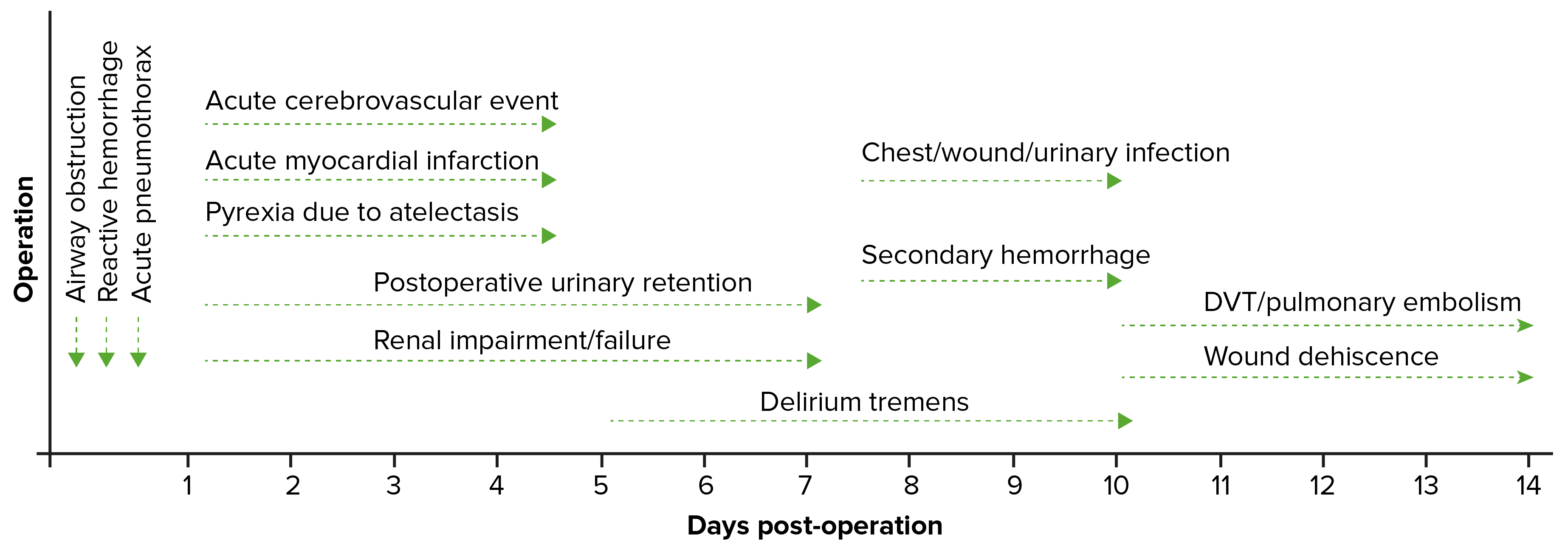Playlist
Show Playlist
Hide Playlist
Trauma and Post-OP Management: Scenario 1
00:01 So, we won't be going too much of detail about trauma because specifically to a couple of scenarios and then we can go through some of the things you need to know in the exam. 00:15 Just a quick scenario. 00:20 Yeah. 00:22 That's what we see. 00:24 Okay, so the management of patient in A&E, so the way we're going to take the scenario is to see if they give you anything in an EMQ, related to trauma you should be able to answer it. 00:36 (inaudible) to what type of trauma it is. 00:38 So, what I'm going to do, Yep, ABC, C-spine, go on, tell me a few more things. 00:46 So, tell me a couple more things about the airway specifically, airway. 00:57 Chin lift, jaw thrust. 00:59 What's a contraindication for nasopharyngeal airway? Basilar skull fractures Okay, how much oxygen do we give? Patients with COPD? 15 liters, very good. 01:11 Okay, circulation. 01:13 Tell me more about circulation. 01:18 Pulse pressure, capillary refill, okay. 01:25 Okay. 01:28 Fine, yeah. 01:29 Okay, and then what would you do along with C? Flux IV fluids. 01:35 Fluids, what fluids, trauma, Hartmann's? Okay. 01:38 How much would you give in a child? 20mil per kl for? 20 mil per kl is fine, I think just thought about the children, 20 mil per kl is fine. 02:01 Right, what else are you worried about? So ABC, Blood loss? Apart from that? One is blood loss, still in circulation. 02:19 Well, maybe peripheral pulses, that's what I was commenting to, peripheral pulses, okay. 02:23 Then, you still you do D, E. 02:27 What else? So, you're done A, B, C, D, E, patience stabilized, you'd done a secondary survey. 02:32 What's next? What else are you thinking of? Particular to the leg specifically? What are you going to do for the leg? Reduce some, where any? Analgesia character. 02:54 For analgesia, but you said reducing, would you reduce this? Okay. 03:00 You said that if there is blood loss, you reduce it. 03:03 Does it, do you reduce it for that? There's a specific indication, huh? Yes. 03:13 With more specific, you're on the right track. 03:15 No. 03:16 You reduce it if you can see a kink to vessel, if you can see an arterial and if you see the posterior tibial artery, which is kink there and you can see by reducing it. 03:24 You can sort of unkink it, then you reduce it. 03:27 But if it is divided, you can't you do, there is no point in reducing it because you'll make it worse. 03:31 Okay? So, reduction is only if you can see a kink vessel, whereby pulling it, you will be able to reduce it. 03:37 Okay. 03:38 Are you worried about about compartment syndrome? Okay, but can you get compartment syndrome in an open fracture? That's right, yes. 03:47 You can get compartment syndrome in the posterior compartment for example or in the thigh. 03:52 So compartment syndrome is something you need to reconsidering. 03:55 Fine. 03:56 Okay, so... 04:05 I don't think we miss anything, have we? No, good. 04:07 Okay. 04:11 Well, come to the next slide here. 04:13 Yes. 04:14 Now, pain relief, tetanus toxoid, antibiotics. 04:19 What antibiotics would you give? And co-amoxiclav, would you give metronidazole? But if you're give co-amoxiclav then probably don't have to. 04:36 If you're given cefrotux cefuroxime, then you have to admit in assault. 04:40 So otherwise, just augmentin. 04:43 What? Thank you. 04:48 Okay, just augmentin is fine. 04:49 Okay, then catheterise, viability of the limb, sensation of the limb, compartment syndrome, x-ray, fracture reduction, nil by mouth for, not NBM, nil by mouth, NBM. 05:02 Okay. 05:02 So, this is a standard principle you need to follow in your exam, for every fracture.
About the Lecture
The lecture Trauma and Post-OP Management: Scenario 1 by Stuart Enoch, PhD is from the course Trauma and Post-OP Management.
Customer reviews
1,5 of 5 stars
| 5 Stars |
|
0 |
| 4 Stars |
|
0 |
| 3 Stars |
|
0 |
| 2 Stars |
|
1 |
| 1 Star |
|
1 |
Horrible. This is the worst material in lecturio. You can do a lot better. I know it. You´ve already have brilliant lessons online
... please provide transkripts or re-record the lecture again. I need 10 words




